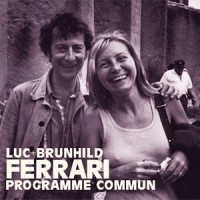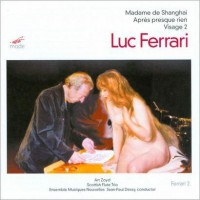Luc and Brunhild (EA Bucket 17.)
|
Grant Chu Covell [March 2013.] Luc FERRARI: Musique Socialiste ou Programme Commun pour clavecin amplifie et bande magnetique (1972)1; Didascalies 2 (1993)2; Les Émois D’Aphrodite (1986, ver. 1998)3. Brunhild FERRARI: Dérivatif (2008); Brumes du réveil (2009); Tranquilles Impatiences (2010). Elisabeth Chojnacka1 (hpsi), Jean-Philippe Collard-Neven2, Claude Berset2 (pno), Vincent Royer2 (vla), The MC Band3: Tony Striplen3 (clar), Kevin Neuhoff3 (perc), John McGinn3 (pno), March Chun3, Mike Touchi3 (synthesizers), March Chun3 (dir.). Sub Rosa SR 363-AB (2 CDs) (http://www.subrosa.net/). Luc FERRARI: Visage 2 (1955-56)1; Après presque rien (2004)2; Madame de Shanghai (1996)3. Art Zoyd2, Musiques Nouvelles1, 2, Jean-Paul Dessy1, 2 (cond.), Li Ping Ting3 (voice), Scottish Flute Trio3. mode 228 (1 CD) (http://www.moderecords.com/). Here we have nine Ferrari works packaged in three groups of three. Sub Rosa pairs two discs in a single release. Like a spouse appointed to complete a decedent politician’s term, so has Brunhild picked up Luc’s work. She has access to a library that would probably intimidate anyone else. Sub Rosa offers her first full-length CD release and hints that there will be more. Programme Commun offers a reunion with an old friend. ADDA 581233 (“Rhythm Plus” with works by Ferrari, Gorecki, Horovitz, Mâche and Knittel), long out of print, features an exhilarating 17 minutes as the harpsichord’s skittering transforms through unremitting pulsing. Here’s my description from 2003:
The title may or may not have anything to do with what we hear. Ferrari chose it to commemorate the passing of France’s 1972 reform program which helped to turn the country leftwards. Ferrari’s note skirts the political role of art, evasively suggesting any relationship. Relentlessness doesn’t usually come to mind in Ferrari, but Didascalies 2’s obsessive hovering connects it with the decades earlier Programme Commun. The unusual instrumentation, two pianos and viola, must be calculated to play tricks upon the listener. The original 2004 Didascalies was for viola and piano; Sub Rosa’s recording (SR 261) was with Collard-Neven and Royer, and mentioned here. Wait a minute! Why does Didascalies 2 show an earlier date? A year after writing Didascalies, Ferrari stumbled across an old score from 1993 for two pianos, retouched it, and after observing similarities with the recent duo, started a series. This may also explain the viola’s outsider role. Les Émois D’Aphrodite demonstrates Ferrari’s perpetually satiric and ironic style. The unusual ensemble of clarinet, percussion, piano and samplers (a progressive rock band coping with absences?) offers repeated yearning phrases, like tendrils twisting to reach the sun. The ensemble resists forward motion, existing episodically. The notes suggest multiple movements in this single track. Luc’s death (August 22, 2005) left at least one project incomplete, and three years had to pass before Brunhild could bring herself to finish the effort. Dérivatif’s plan was to peruse every thirteenth tape from the archives and extract an excerpt. In Brunhild’s completion, field recordings, works-in-progress and finished projects blend together. It must have been a charged effort: Brunhild remarks how each tape brought back the memories of its circumstances. I thought I heard a bit of the 36 Enfilades tape among others in this collage. Brumes du réveil unspools more traditionally with smoother transitions. As its title “Half Awake” implies, the work is subdued, expressing slumbering slow motion with faster events kept at bay. Where Dérivatif used Luc’s recipe, for the darker Brumes Brunhild states that she followed her own intuition and desires. It’s oneiric ea, pure and simple. Perhaps the few ethnic samples help sketch a narrative thread. Somehow, the electronic arcade sounds manage to be sinister. I have trouble understanding Luc’s words towards the end. Brunhild’s third piece is completely different. Droning and trancelike, Tranquilles Impatiences also takes a leisurely pace, with synthesized textures dominating (including pulsing recalling Programme Commun). Brunhild took tapes from two 1977 works, Et tournent les sons dans la garrigue and Exercises d’Improvisation. The work balances a smoother ground with high-pitched rhythmic bursts. But like Brumes, the result is sober rather than bright. Judging from these three pieces, Brunhild appears less tolerant of absurdity. Composed in a heady period when Luc was developing a personal voice that would rise above serialism’s thicket, Visage 2 was never actually performed near the time it was completed. Mode offers a first recording and perhaps premiere performance. We hear a voluble ten minutes for brass, piano and percussion which Luc insisted was about the “physical confrontation of two sexual bodies.” Well, perhaps. I imagine in the mid-fifties anything so blatantly emotional and physical might have been extreme indeed. Other Visages play with serialism, and so it’s best to consider this installment as a reaction or arch commentary. Stretching to 31 minutes, Après presque rien requires 14 performers and two samplers triggering taped sounds. Luc’s involved program note relates how he didn’t want Presque rien “avec instruments” (also titled Exploitation des Concepts No. 5) to be the terminus of the Presque rien line and so brought out this item. Luc appropriates different guises in an effort to avoid habits, but of course he was always idiosyncratic. The pre-recorded bits appear after threadbare spots, thus the more surprising. Later the repeating tape effects annoy just a bit – typical Ferrari. Madame de Shanghai is scored for three flutes and tape. The milieu is Paris’ Asian markets and the subtext is Li Ping Ting seeking out the eponymous Orson Welles movie until by some aural twist she falls into the celluloid. It’s surreal and situational, a sci-fi radio play. No offense to its members, but simply discovering that there’s an active ensemble named Scottish Flute Trio (Ruth Morley, Laura Bailie and Janet Larsson) brings on a smile. I imagine this item will delight hardcore fans. I still find it discomfiting to hear Luc’s voice on tape.
[More EA Bucket, Grant Chu Covell]
[More
Ferrari, Meyer-Ferrari]
[Previous Article:
Schnittke’s Fourth Quartet]
[Next Article:
Mostly Symphonies 21.]
|

